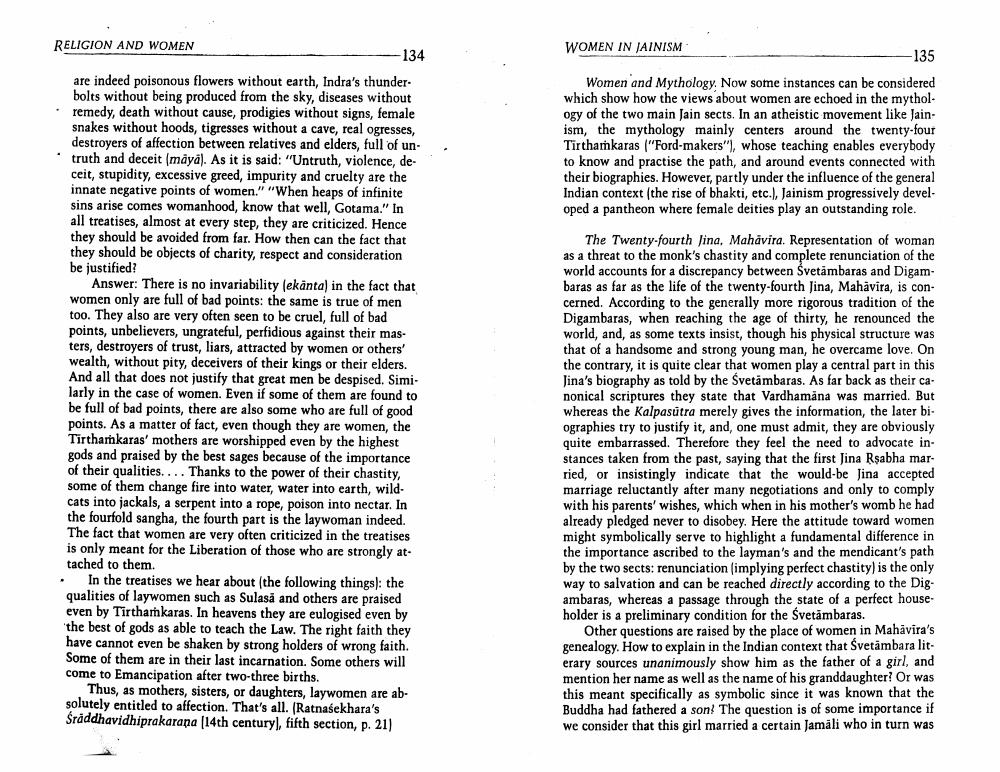Book Title: Women In Jainism Author(s): Nalini Balbir Publisher: Nalini Balbir View full book textPage 8
________________ RELIGION AND WOMEN WOMEN IN JAINISM - 134 -135 Women and Mythology. Now some instances can be considered which show how the views about women are echoed in the mythol. ogy of the two main Jain sects. In an atheistic movement like Jain. ism, the mythology mainly centers around the twenty-four Tirthamkaras ("Ford-makers"), whose teaching enables everybody to know and practise the path, and around events connected with their biographies. However, partly under the influence of the general Indian context (the rise of bhakti, etc.), Jainism progressively developed a pantheon where female deities play an outstanding role. are indeed poisonous flowers without earth, Indra's thunder bolts without being produced from the sky, diseases without remedy, death without cause, prodigies without signs, female snakes without hoods, tigresses without a cave, real ogresses, destroyers of affection between relatives and elders, full of untruth and deceit (māya). As it is said: "'Untruth, violence, deceit, stupidity, excessive greed, impurity and cruelty are the innate negative points of women." "When heaps of infinite sins arise comes womanhood, know that well, Gotama." In all treatises, almost at every step, they are criticized. Hence they should be avoided from far. How then can the fact that they should be objects of charity, respect and consideration be justified? Answer: There is no invariability (ekanta) in the fact that women only are full of bad points: the same is true of men too. They also are very often seen to be cruel, full of bad points, unbelievers, ungrateful, perfidious against their mas. ters, destroyers of trust, liars, attracted by women or others' wealth, without pity, deceivers of their kings or their elders. And all that does not justify that great men be despised. Similarly in the case of women. Even if some of them are found to be full of bad points, there are also some who are full of good points. As a matter of fact, even though they are women, the Tirthamkaras' mothers are worshipped even by the highest gods and praised by the best sages because of the importance of their qualities. ... Thanks to the power of their chastity, some of them change fire into water, water into earth, wildcats into jackals, a serpent into a rope, poison into nectar. In the fourfold sangha, the fourth part is the laywoman indeed. The fact that women are very often criticized in the treatises is only meant for the Liberation of those who are strongly at tached to them. • In the treatises we hear about the following things): the qualities of laywomen such as Sulaså and others are praised even by Tirthamkaras. In heavens they are eulogised even by the best of gods as able to teach the Law. The right faith they have cannot even be shaken by strong holders of wrong faith. Some of them are in their last incarnation. Some others will come to Emancipation after two-three births. Thus, as mothers, sisters, or daughters, laywomen are ab. solutely entitled to affection. That's all. (Ratnasekhara's Sraddhavidhiprakarana (14th century), fifth section, p. 21) The Twenty-fourth Jina. Mahavira. Representation of woman as a threat to the monk's chastity and complete renunciation of the world accounts for a discrepancy between Svetambaras and Digambaras as far as the life of the twenty-fourth Jina, Mahavira, is con cerned. According to the generally more rigorous tradition of the Digambaras, when reaching the age of thirty, he renounced the world, and, as some texts insist, though his physical structure was that of a handsome and strong young man, he overcame love. On the contrary, it is quite clear that women play a central part in this Jina's biography as told by the Svetambaras. As far back as their ca. nonical scriptures they state that Vardhamana was married. But whereas the Kalpasutra merely gives the information, the later bi. ographies try to justify it, and, one must admit, they are obviously quite embarrassed. Therefore they feel the need to advocate in stances taken from the past, saying that the first Jina Rşabha mar. ried, or insistingly indicate that the would-be Jina accepted marriage reluctantly after many negotiations and only to comply with his parents' wishes, which when in his mother's womb he had already pledged never to disobey. Here the attitude toward women might symbolically serve to highlight a fundamental difference in the importance ascribed to the layman's and the mendicant's path by the two sects: renunciation (implying perfect chastity) is the only way to salvation and can be reached directly according to the Dig. ambaras, whereas a passage through the state of a perfect house holder is a preliminary condition for the Svetämbaras. Other questions are raised by the place of women in Mahavira's genealogy. How to explain in the Indian context that Svetambara literary sources unanimously show him as the father of a girl, and mention her name as well as the name of his granddaughter? Or was this meant specifically as symbolic since it was known that the Buddha had fathered a son! The question is of some importance if we consider that this girl married a certain Jamali who in turn wasPage Navigation
1 ... 6 7 8 9 10 11 12
